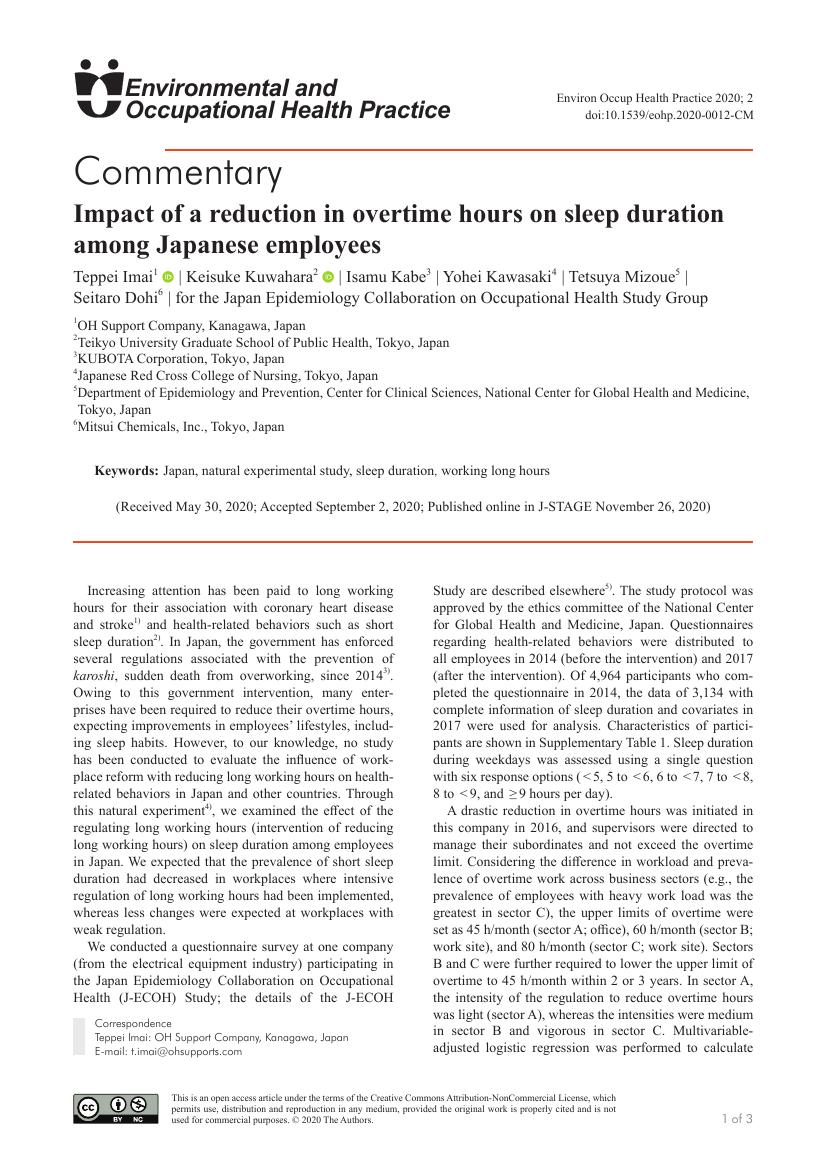- 著者
- Shamima Akter Tohru Nakagawa Toru Honda Shuichiro Yamamoto Keisuke Kuwahara Hiroko Okazaki Huanhuan Hu Teppei Imai Akiko Nishihara Toshiaki Miyamoto Naoko Sasaki Takayuki Ogasawara Akihiko Uehara Makoto Yamamoto Taizo Murakami Makiko Shimizu Masafumi Eguchi Takeshi Kochi Ai Hori Satsue Nagahama Kentaro Tomita Maki Konishi Ikuko Kashino Akiko Nanri Isamu Kabe Tetsuya Mizoue Naoki Kunugita Seitaro Dohi for the Japan Epidemiology Collaboration on Occupational Health Study Group
- 出版者
- The Japanese Circulation Society
- 雑誌
- Circulation Journal (ISSN:13469843)
- 巻号頁・発行日
- vol.82, no.12, pp.3005-3012, 2018-11-24 (Released:2018-11-24)
- 参考文献数
- 28
- 被引用文献数
- 20
Background: The effect of smoking on mortality in working-age adults remains unclear. Accordingly, we compared the effects of cigarette smoking and smoking cessation on total and cause-specific mortality in a Japanese working population. Methods and Results: This study included 79,114 Japanese workers aged 20–85 years who participated in the Japan Epidemiology Collaboration on Occupational Health Study. Deaths and causes of death were identified from death certificates, sick leave documents, family confirmation, and other sources. Hazard ratios (HRs) and 95% confidence intervals (CIs) were estimated via Cox proportional hazards regression. During a maximum 6-year follow-up, there were 252 deaths in total. Multivariable-adjusted HRs (95% CIs) for total mortality, cardiovascular disease (CVD) mortality, and tobacco-related cancer mortality were 1.49 (1.10–2.01), 1.79 (0.99–3.24), and 1.80 (1.02–3.19), respectively, in current vs. never smokers. Among current smokers, the risks of total, tobacco-related cancer, and CVD mortality increased with increasing cigarette consumption (Ptrend<0.05 for all). Compared with never smokers, former smokers who quit <5 and ≥5 years before baseline had HRs (95% CIs) for total mortality of 1.80 (1.00–3.25) and 1.02 (0.57–1.82), respectively. Conclusions: In this cohort of workers, cigarette smoking was associated with increased risk of death from all and specific causes (including CVD and tobacco-related cancer), although these risks diminished 5 years after smoking cessation.
- 著者
- Teppei Imai Keisuke Kuwahara Isamu Kabe Yohei Kawasaki Tetsuya Mizoue Seitaro Dohi for the Japan Epidemiology Collaboration on Occupational Health Study Group
- 出版者
- Japan Society for Occupational Health
- 雑誌
- Environmental and Occupational Health Practice (ISSN:24344931)
- 巻号頁・発行日
- vol.2, no.1, pp.2020-0012-CM, 2020 (Released:2020-12-25)
- 参考文献数
- 10
- 著者
- Huan Hu Ami Fukunaga Toshitaka Yokoya Tohru Nakagawa Toru Honda Shuichiro Yamamoto Hiroko Okazaki Toshiaki Miyamoto Naoko Sasaki Takayuki Ogasawara Naoki Gonmori Kenya Yamamoto Ai Hori Kentaro Tomita Satsue Nagahama Maki Konishi Nobumi Katayama Hisayoshi Morioka Isamu Kabe Tetsuya Mizoue Seitaro Dohi for the Japan Epidemiology Collaboration on Occupational Health Study Group
- 出版者
- Japan Atherosclerosis Society
- 雑誌
- Journal of Atherosclerosis and Thrombosis (ISSN:13403478)
- 巻号頁・発行日
- pp.63118, (Released:2021-10-23)
- 参考文献数
- 32
- 被引用文献数
- 5
Aims: We aimed to investigate the association between non-high-density lipoprotein cholesterol (non-HDL-C) levels and the risk of cardiovascular disease (CVD) and its subtypes. Methods: In this contemporary cohort study, we analyzed the data of 63,814 Japanese employees aged ≥ 30 years, without known CVD in 2012 and who were followed up for up to 8 years. The non-HDL-C level was divided into 5 groups: <110, 110-129, 130-149, 150-169, and ≥ 170 mg/dL. The Cox proportional hazards model was used to calculate the hazard ratios (HRs) and the corresponding 95% confidence intervals (CIs) for CVD and its subtypes associated with each non-HDL-C group, considering 130-149 mg/dL as the reference group. Results: During the study period, 271 participants developed CVD, including 78 myocardial infarctions and 193 strokes (102 ischemic strokes, 89 hemorrhagic strokes, and 2 unknowns). A U-shaped association between non-HDL-C and stroke was observed. In the analysis of stroke subtypes, the multivariable-adjusted HR (95% CI) for hemorrhagic stroke was 2.61 (1.19–5.72), 2.02 (0.95–4.29), 2.10 (1.01–4.36), and 1.98 (0.96-4.08), while that for ischemic stroke was 1.54 (0.77-3.07), 0.91 (0.46-1.80), 0.73 (0.38-1.41), and 1.50 (0.87-2.56) in the <110, 110-129, 150-169, and ≥ 170 mg/dL groups, respectively. Individuals with elevated non-HDL-C levels had a higher risk of myocardial infarction. Conclusions: High non-HDL-C levels were associated with an increased risk of myocardial infarction. Moreover, high and low non-HDL-C levels were associated with a high risk of stroke and its subtypes among Japanese workers.
- 著者
- Huanhuan Hu Tohru Nakagawa Toru Honda Shuichiro Yamamoto Akiko Nanri Maki Konishi Hiroko Okazaki Keisuke Kuwahara Ai Hori Chihiro Nishiura Ikuko Kashino Teppei Imai Akiko Nishihara Shamima Akter Toshiaki Miyamoto Naoko Sasaki Takayuki Ogasawara Akihiko Uehara Makoto Yamamoto Taizo Murakami Makiko Shimizu Masafumi Eguchi Takeshi Kochi Satsue Nagahama Kentaro Tomita Isamu Kabe Tetsuya Mizoue Tomofumi Sone Seitaro Dohi for the Japan Epidemiology Collaboration on Occupational Health Study Group
- 出版者
- The Japanese Circulation Society
- 雑誌
- Circulation Journal (ISSN:13469843)
- 巻号頁・発行日
- vol.82, no.2, pp.430-436, 2018-01-25 (Released:2018-01-25)
- 参考文献数
- 22
- 被引用文献数
- 8
Background:We investigated the risk of cardiovascular disease (CVD) with duration of metabolic syndrome (MetS) for the past 4 years before the CVD event.Methods and Results:We performed a nested case-control study within the Japan Epidemiology Collaboration on Occupational Health Study. A total of 139 registered cases of CVD and 561 self-reported cases of CVD were identified and matched individually on age, sex, and worksite with 695 and 2,803 controls, respectively. MetS was defined by the Joint Interim Statement definition. The odds ratio (95% confidence interval) for registered CVD was 4.7 (2.9, 7.5) for people with persistent MetS (positive for MetS for ≥3 assessments) and 1.9 (1.1, 3.3) for those with intermittent MetS (positive for MetS for 1–2 assessments), compared with people without MetS during the past 4 years before the event/index date (P for trend <0.001). The corresponding odds ratio for self-reported CVD was 2.7 (2.2, 3.5) and 1.8 (1.4, 2.3) (P for trend <0.001). The association with MetS duration was stronger for myocardial infarction than for other CVD subtypes. Similar results were obtained when using the Japanese MetS criteria.Conclusions:The risk of CVD increases with increasing MetS duration. These findings contribute to risk stratification and encourage lifestyle modification for people with MetS to minimize their health risk.
